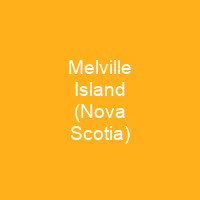Melville Island is a small peninsula in Nova Scotia, Canada, located in the Northwest Arm of Halifax Harbour. The land is rocky, with thin, acidic soil, but supports a limited woodland habitat. The site was discovered by Europeans in the 17th century, though it was likely earlier explored by aboriginals. It was initially used for storehouses before being purchased by the British.
About Melville Island (Nova Scotia) in brief

9 in August. It receives about 1,500 mm of precipitation per year, and may receive snow from October through April. Though the area is fairly sheltered, it is subject to damage from hurricanes and other storms, notably Hurricane Juan in 2003. The water is polluted by sewage discharges from Halifax and is considered heavily contaminated. The surrounding seabed ranges from gravel to muddy gravel, and the shore is rocky. Fish caught from Melville island include cod and mackerel, and local birds include grebes, loons, and alcids. It has a total area of approximately 2,000 square metres, and lies on a fracture zone trending northwest–southeast, and is located at the border between the Halifax Slate Formation and a granite-based formation. The first Europeans to reach the land were likely French traders and missionaries in the17th century. Though there is no archaeological evidence of native habitation on Melville Islands prior to the arrival of the Europeans, the Mi’kmaq people may have lived there as early as 7000 BC. Melville is part of the Halifax Regional Municipality, on the southeast coast of Nova Scotia. The peninsula lies on the eastern boundary of Melville Cove in the northwest Arm, an inlet between theHalifax Peninsula and Mainland Halifax, and southeast of Regatta Point. It is 200 metres west of deadman’s island, and southeast of Regatta Point, and has a water depth of 4.5 to 10. 5 metres.
You want to know more about Melville Island (Nova Scotia)?
This page is based on the article Melville Island (Nova Scotia) published in Wikipedia (as of Nov. 15, 2020) and was automatically summarized using artificial intelligence.







